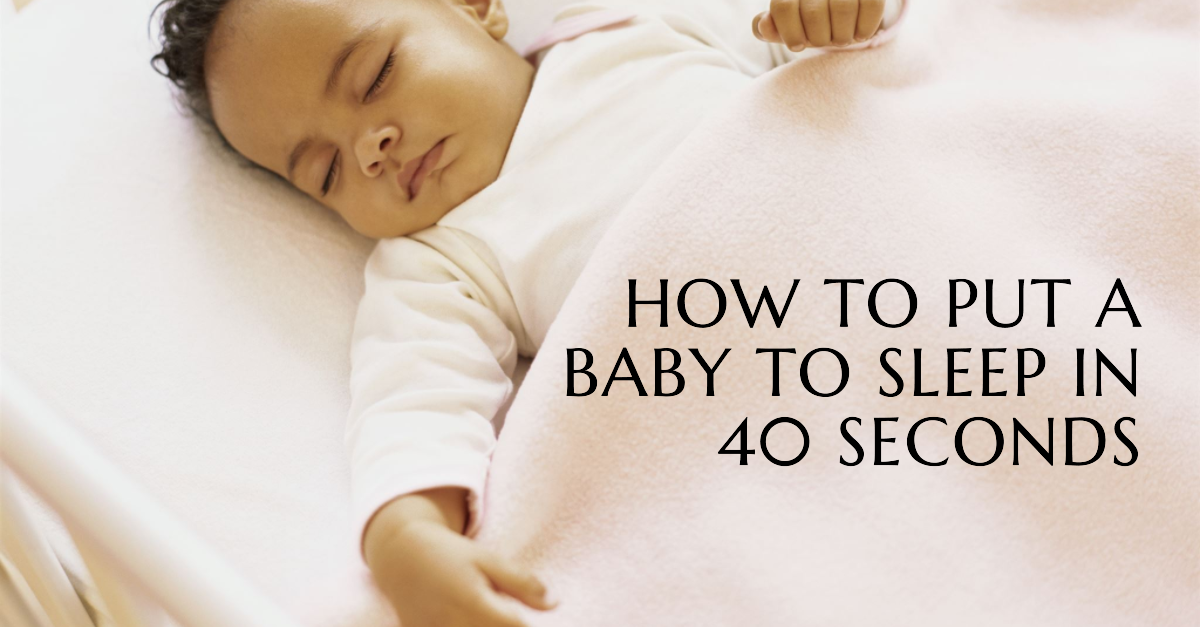
Hey there, dear parent! Have you ever found yourself frantically pacing the floor, cradling a crying baby, wishing there was a magic button to send them off to dreamland? You're not alone. Many parents have dreamt of that elusive 40-second trick to put their baby to sleep. Well, guess what? While it might not be literal magic, there are techniques and strategies that might just do the trick! Ready for this journey? Hold on tight!
Understanding Babies' Sleep Cycles
You see, putting a baby to sleep is a lot like baking a cake. You might wonder, "What does baking have to do with sleep?" Well, just as you need the right ingredients and timings to get that cake perfectly fluffy, understanding your baby's sleep patterns is crucial. Babies, unlike adults, have shorter sleep cycles. By tapping into this knowledge, you can help set the stage for quicker sleep transitions.
The Power of a Routine
- Consistency is Key: Babies love routine. Like clockwork, their bodies begin to recognize sleep cues.
- Activities Before Bedtime: Simple activities like reading a book or a gentle massage can signal it's time to wind down.
How To Put A Baby To Sleep In 40 Seconds

Step 1. Dimming the Lights
Bright lights are like an alarm clock for babies. They indicate playtime! Slowly dimming the lights can be the cue that bedtime is approaching, like a gentle sunset leading to nighttime.
Step 2. Soothing Sounds
Ever heard of white noise? This is the background sound that creates a consistent environment. It can mask other sounds that might be disruptive. For babies, it's reminiscent of the sounds in the womb.
Step 3. Warm Baths: A Prelude to Sleep
There's nothing quite like a warm bath to soothe those tiny muscles. It's like giving them a mini spa session before bedtime.
Step 4. Gentle Rocking Motion
Remember those times when a gentle car ride sent your baby straight to sleep? It's all about the movement. Gently rocking your baby mimics the swaying they felt in the womb.
Step 5. The Right Sleep Environment
- Firm Mattress: This offers support and safety.
- No Loose Blankets: These can be a suffocation hazard.
- Cool, Dark, and Quiet Room: Creates the ideal ambiance for sleep.
Step 6. Limiting Stimulants
It's like drinking a coffee before bed. For babies, stimulants can be things like sugar or even exciting play right before sleep. It gets their adrenaline pumping, making sleep elusive.
Step 7. Comfortable Clothing
Imagine trying to sleep in an itchy sweater. Not the best feeling, is it? Now, let's talk about your little bundle of joy. For babies, the right attire is crucial for a peaceful slumber. Enter baby rompers: these snug, easy-to-wear pieces ensure your baby is cocooned in comfort. And then there's the magic of comfortable bodysuits. Breathable and practical, they not only keep your baby comfy but also simplify those frequent diaper changes. In the world of baby clothing, these two items can be game-changers for ensuring a restful sleep.
Step 8. Soothing Touch
Sometimes, all it takes is the gentle touch of a parent to reassure a baby. A gentle pat, a caress, or even just holding their hand can be enough.
Understanding Overstimulation
It's like being at a loud concert and then trying to sleep right after. Babies can get overstimulated too! Recognize the signs and help them wind down.
Benefits of the 40-Second Sleep Methods
- Enhanced Rest for the Baby: A well-rested baby is a happy baby.
- Peaceful Nights for Parents: Reduced sleep-time battles lead to rejuvenated parents.
- Strengthening Parent-Baby Bond: Effective sleep techniques reduce stress, fostering a stronger bond.
Safety First!
1. Back to Sleep:
Always place your baby on their back to sleep, whether it's nap time or bedtime. This position significantly reduces the risk of Sudden Infant Death Syndrome (SIDS).
2. Toy-Free Zone:
While stuffed animals and toys might look cute in the crib, they can pose a suffocation risk. Keep the crib free from toys, pillows, and heavy blankets.
3. Firm Sleep Surface:
Use a firm mattress in a safety-approved crib. Soft surfaces can mold to a baby's face and disrupt their breathing.
4. Check for Crib Safety:
Ensure there are no gaps larger than two fingers between the sides of the crib and the mattress. Regularly inspect the crib for loose parts or broken slats.
5. Dress Smart:
Dress your baby in light sleepwear. Avoid blankets; instead, consider using a sleep sack or wearable blanket if you're worried about them getting cold.
6. Temperature Check:
Keep the room at a comfortable temperature, ideally between 68-72°F (20-22°C). Babies can overheat easily, so it's essential to ensure the room isn't too warm.
7. Smoke-Free Environment:
Never smoke around your baby or in their environment. Second-hand smoke increases the risk of SIDS (Sudden infant death syndrome).
Are There Any Downsides?
Like every method, what works for one baby might not for another. It's essential to be patient and try different techniques to find the one that suits your little one best.
FAQs
Is white noise safe for babies?
Yes, as long as it's at a safe volume. It shouldn't be too loud but just enough to mask disruptive noises.
How do I know if my baby is overstimulated?
Signs include fussiness, avoiding eye contact, and looking away. If they seem agitated after a lot of activity, they might need some quiet time.
What if these methods don't work for my baby?
Every baby is different. It's essential to try different techniques and see what resonates with your child. Sometimes, it's a combination of methods that work best.
How often should I change my baby's sleep routine?
Consistency is vital for babies. However, as they grow, their needs change. Be observant, and you'll know when to make slight adjustments.
Also check my guide on Top 13 Summer Clothing Tips For Kids
In Conclusion
So, while 40 seconds might be an ambitious target, with the right techniques and understanding, you can significantly reduce the time it takes to put your baby to sleep. Remember, every baby is unique. What works for one might not work for another. It's all about finding that perfect lullaby method for your little one.
